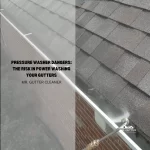Gutters play a crucial role in home maintenance by directing rainwater away from the foundation and protecting the structural integrity of a house.
Their importance cannot be overstated, as they help prevent potential water damage, soil erosion, and foundation problems.
The necessity for gutters depends on several factors, including the architectural design of the house, the local climate, and the home’s surrounding environment.
Properly chosen and installed gutters contribute significantly to water management, ensuring that rainwater flows away from the building efficiently.
Moreover, understanding the various types of gutters and their materials can aid in selecting the most durable and effective solution for a specific home.
Maintenance is also key to extending the life of gutters, with regular cleaning and inspection being essential for preventing blockages and leaks.
For homes where traditional gutters may not be suitable, innovative drainage solutions offer alternative methods for managing rainwater.
Ultimately, deciding whether a house needs gutters involves assessing these key considerations to protect the home from water-related issues effectively.
What Are Gutters and Why Are They Important?
Gutters serve a fundamental role in home maintenance by managing water flow around a house. They direct rainwater away from the foundation, walls, and landscaping, significantly reducing the risk of water damage and soil erosion.
This system’s design ensures that water from the roof is collected and channeled safely away from the building’s structure, safeguarding the home’s integrity and the homeowner’s investment.
Table of Contents:
The Role of Gutters in Home Maintenance
Gutters contribute to home maintenance by preventing water accumulation around the base of a house. This prevention is critical as standing water can lead to foundation weakening, basement flooding, and the growth of mold and mildew. By efficiently directing water away, gutters maintain the structural stability of a home and contribute to a healthy, damp-free living environment.
How Gutters Protect Your Home from Water Damage
The protection gutters offer against water damage is multifaceted. They prevent rainwater from spilling off the roof directly onto the ground below, which can cause soil erosion and saturate the foundation. Additionally, by keeping the siding and exterior walls dry, gutters help in avoiding the deterioration of building materials. This protection extends the lifespan of the home’s exterior surfaces and reduces maintenance costs over time.
Factors Influencing the Need for Gutters in a House
The necessity for gutters on a house is influenced by several key factors, each contributing to the overall efficiency of water management for the property. Understanding these factors helps homeowners make informed decisions regarding gutter installation to protect their homes effectively.
Architectural Design and Its Impact on Water Drainage
The architectural design of a house significantly affects its water drainage needs. Roofs with complex designs or multiple valleys channel more water to certain areas, necessitating a gutter system that can handle the increased flow. Additionally, the roof’s slope determines how quickly water is shed, influencing the size and type of gutters required for optimal performance.
The Influence of Climate on Gutter Necessity
Climate plays a crucial role in determining the need for gutters. In regions with heavy rainfall or snowfall, gutters are essential for directing large volumes of water away from the property, preventing water damage. Conversely, in arid climates, the necessity for gutters may be reduced, though they still provide value in managing infrequent but potentially heavy downpours.
Assessing Your Home’s Surroundings and Gutter Requirements
The home’s surroundings also impact the need for gutters. Homes surrounded by trees may require gutters to prevent leaves and debris from blocking water flow off the roof. Similarly, properties on a slope or in close proximity to other structures may need a well-designed gutter system to manage water runoff effectively, ensuring it is directed away from the foundation.
The Consequences of Not Having Gutters
Neglecting to install gutters on a house can lead to a series of detrimental effects, impacting the home’s structural integrity and the overall safety of its occupants. The absence of a proper drainage system can precipitate several issues, ranging from minor inconveniences to severe damage.
Potential Water Damage and Its Effects
Without gutters, rainwater falls directly from the roof to the ground near the foundation, leading to potential water damage. This water can penetrate the basement or crawl spaces, causing dampness, mold, and mildew growth. Over time, continuous water exposure can deteriorate the home’s exterior walls, paint, and siding, necessitating costly repairs and maintenance.
Foundation Problems Due to Inadequate Drainage
One of the most significant risks of foregoing gutters is the impact on the house’s foundation. Water pooling around the foundation can weaken its structure, leading to cracks, settling, and in extreme cases, foundational failure. Such damage not only compromises the safety of the structure but also dramatically decreases the property’s value and necessitates extensive and expensive repairs.
The Risk of Soil Erosion and Landscaping Issues
The direct impact of rainwater can strip the soil of its nutrients, leading to erosion around the property. This erosion affects landscaping, gardens, and can even alter the property’s grading, directing more water towards the house. Additionally, without gutters, water can wash away mulch, damage plants, and create unsightly gullies in the yard.
Types of Gutters and Their Benefits
Choosing the right type of gutters for a house is crucial for optimizing water management and protecting the property from the adverse effects of water damage. Various gutter types offer distinct benefits, catering to different architectural styles, climates, and homeowner preferences.
Materials and Durability: Choosing the Right Gutters
Gutters come in a variety of materials, each with its own set of advantages. Aluminum gutters, for example, are lightweight, resistant to corrosion, and available in a wide range of colors to match any home exterior. Vinyl gutters offer ease of installation and are cost-effective, though they may not withstand extreme temperatures as well as metal options. Copper and steel gutters are known for their durability and longevity, adding a classic or upscale look to a home’s exterior but at a higher cost. Selecting the right material involves balancing cost, aesthetics, and the specific weather conditions of the area.
Gutter Designs and Their Effectiveness in Water Management
The design of the gutter system also plays a pivotal role in its effectiveness. Traditional sectional gutters are pieced together and can be more prone to leaks, but they allow for easy replacement of damaged sections. Seamless gutters, on the other hand, are custom-fitted to the home and minimize leaks by reducing the number of joints. The shape of gutters, such as K-style or half-round, affects their capacity and how well they blend with the home’s architectural style. Furthermore, the incorporation of gutter guards can prevent clogging from leaves and debris, reducing maintenance needs and improving the longevity of the gutter system.
Installation and Maintenance of Gutters
Proper installation and regular maintenance are critical to ensuring that gutters perform their intended function effectively. These elements guarantee that gutters remain clear and operational, thus protecting the home from water damage over time.
Professional Installation vs. DIY: What You Need to Know
When it comes to gutter installation, homeowners face the choice between professional installation and the DIY approach.
Professional installation ensures that gutters are correctly sized, securely fastened, and optimally positioned for effective water drainage, taking into account the home’s specific architectural features and the local climate.
This option often comes with warranties and guarantees for workmanship and materials.
On the other hand, DIY installation can be cost-effective for those with the necessary skills and tools.
However, it requires a thorough understanding of gutter systems, and mistakes can lead to ineffective water management or damage to the home.
Essential Maintenance Tips to Extend Gutter Life
Regular maintenance is crucial to the longevity and functionality of gutter systems. This includes periodic cleaning to remove leaves, twigs, and debris that can clog the gutters and downspouts, preventing water from flowing freely. Homeowners should also inspect gutters for signs of wear, such as rust, holes, and sagging, and make repairs promptly to avoid water damage. Additionally, checking and ensuring that downspouts discharge water away from the foundation is essential to prevent erosion and foundation issues. Implementing gutter guards can reduce the amount of debris entering the system, thereby minimizing maintenance requirements.
Alternatives to Traditional Gutters
Exploring alternatives to traditional gutter systems can offer homeowners innovative solutions to water management challenges, especially in unique architectural situations or for aesthetic preferences. These alternatives can range from less intrusive designs to completely gutter-free options, providing different methods for directing rainwater away from a home’s foundation.
Innovative Drainage Solutions for Homes Without Gutters
For homes where traditional gutters are not feasible or desired, several innovative drainage solutions exist. Rain chains, for instance, serve as decorative alternatives to downspouts, guiding rainwater from the roof to the ground in a visually pleasing manner. Dry wells and rain gardens are ground-level solutions that manage runoff by absorbing and dispersing water naturally into the earth, reducing the risk of soil erosion and water damage to the foundation. French drains, another effective alternative, capture water at the ground level and redirect it away from the home’s foundation through a buried perforated pipe.
Evaluating the Effectiveness of Gutter Alternatives
When considering alternatives to traditional gutters, it’s crucial to evaluate their effectiveness in the specific context of a home’s location, design, and the typical weather patterns of the area. While these alternatives can provide effective water management and aesthetic appeal, they may not offer the same level of protection as conventional gutters in areas prone to heavy rainfall or snow. Consulting with a professional can help homeowners assess the best solution for their needs, ensuring that their chosen method effectively protects their home from water damage.
Making the Decision: Does Your House Need Gutters?
Deciding whether a house needs gutters involves a comprehensive assessment of various factors that impact water management and the potential for water damage. This decision should be informed by the specific needs of the property, considering both the immediate benefits and the long-term maintenance commitments.
Key Considerations Before Installing Gutters
Before proceeding with gutter installation, homeowners should evaluate several key considerations. These include the home’s architectural design, which influences the volume and flow of rainwater off the roof, and the local climate, particularly the frequency and intensity of rainfall. The property’s landscaping and the ground’s ability to absorb water also play crucial roles. Additionally, the cost of installation and ongoing maintenance requirements should be weighed against the potential cost of water damage repairs should gutters not be installed.
How to Assess Your Home’s Gutter Needs
Assessing a home’s need for gutters starts with observing the effects of rainwater around the property. Signs such as pooling water near the foundation, erosion in the landscaping, or water marks on the siding indicate the need for improved water management. Consulting with professionals can provide insights into the best types of gutters for the home’s specific conditions, considering factors like roof size and pitch, as well as aesthetic preferences. Homeowners should also consider the long-term benefits of gutters, including reduced maintenance and repair costs, in their decision-making process.


